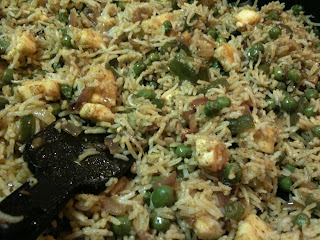When I was wondering what should be the next recipe, my friend Shashi, who is a "food swain", suggested Aloo Gobi! Sure it is a very popular North Indian curry, which you will find in almost all the Indian restaurants' menu. I like to experiment with my dishes to make it quick yet delicious. And here, I am going to tell you just how to make the restaurant style Aloo Gobi in the shortest amount of time.
Aloo is a Hindi word for Potato and Gobi is for Cauliflower. Together they serve as a great combination to eat with bread, roti etc. Well again like my friend says, anything with aloo tastes good. Lol! Do not take it literally though, cos some vegetables are too awkward to be cooked with aloo, for instance Radish, Beetroot. Nope, not at all!
So for Aloo Gobi, you will have to keep ready
- 1 large bowl of Cauliflower, cut into bite size florets
- 1 large bowl of peeled Potatoes, cut into bite size cubes
- 1 Onion finely chopped
- 1 cup frozen or fresh Peas
- 3 cloves of Garlic and 1 inch of Ginger (2 tbsp of ginger garlic paste serves just fine)
- 2 Tomatoes and 1/2 Onion chopped into big pieces
- 1 tbsp Cumin/Jeera seeds
- 1 tsp Coriander powder
- 1 tsp Jeera/Cumin powder
- 1 tsp Dry Mango/Amchoor powder
- 1/2 tsp Garam Masala
- Red Chilli powder 1/2 tsp (Add more if you like it more spicy hot)
- Pinch of Asafoetida
- 8 sprigs of chopped Cilantro/Coriander
- 5 tbsp Oil (More if you like it crispy, less if you are calorie conscious)
- Salt
I promised you earlier that I shall give you tips on making this a quicker process. So start with salting the potatoes slightly and popping it in the microwave for 4 mins approx. Cook the cauliflower for 4 mins as well, separately in the microwave. If you do not use microwave, keep the potatoes and cauliflower to boil in a lot of water with salt. Simultaneously, heat oil in a large non-stick Saute` pan, add cumin seeds and asafoetida and let it sizzle. Then toss onions into the pan and saute` till it is half cooked. While onions are getting done, you can go ahead and blend ginger, garlic, onion, tomato and red chilli powder into coarse paste. Try using as little water as you can to get this blended mixture. When onions turn nicely golden brown on the pan, add this paste and give it a good stir. Close the lid and let it cook for 3 mins with regular stirring. During this time, drain the potatoes and cauliflower.
Take some water in a small bowl and add coriander powder, cumin powder, dry mango powder and garam masala and mix it well. Check the color of the paste in the pan, if it is dark and if oil starts separating, it is time to add this masala mix. Add salt and stir it well. Now goes potatoes and peas in the pan. Remember no more water! Cook it in masala for about 4 mins and add cauliflower, toss it well so the spices are evenly distributed and let this cook with lid closed for another 4 mins. Add a bit of salt and give a quick stir. Once the heat is shut, sprinkle it with coriander/cilantro.
Well some people do not believe in multi-tasking. Share this recipe and ask them to follow the same procedure. You will make a believer in them!
Points to remember:
- While using a non-stick pan, use only and only wooden spatula. You do not want to scrape the teflon coating by using a metallic spatula and the coating does not even add flavor to your dish. Huh!?!
- Relax you starch freaks. You are not eating a whole bucket of fries here. Potatoes are not all that bad. But if you strictly think otherwise, sorry for this recipe and sorry that you would not hog such a delicious dish.
- If the cauliflower is fresh and not frozen, then I would suggest you keep it in hot salt water for at least 10 mins to avoid any biological actions. This mainly applies to folks using cauliflower in India.
- Save the peeled and cut potato cubes in water to avoid its darkening.
- Be creative and try substituting cauliflower with capsicum/green pepper or just peas to make aloo capsicum and aloo mutter respectively. But remember every vegetable has its own sweetness, in case of aloo capsicum you have to add less chilli powder and in case of aloo mutter you have to add a little more chilli powder to compliment the sweetness of peas.
Practice makes anyone perfect. So try this recipe, once and many more times if you like it! Do not forget to drop me a message in the comments section. If you have any particular dish in mind, write to me and I shall try to post those recipes as soon as I can.
Note:
tbsp = Tablespoon (larger spoon)
tsp = Teaspoon (smaller spoon)
1 tbsp = 3 tsp approx.



